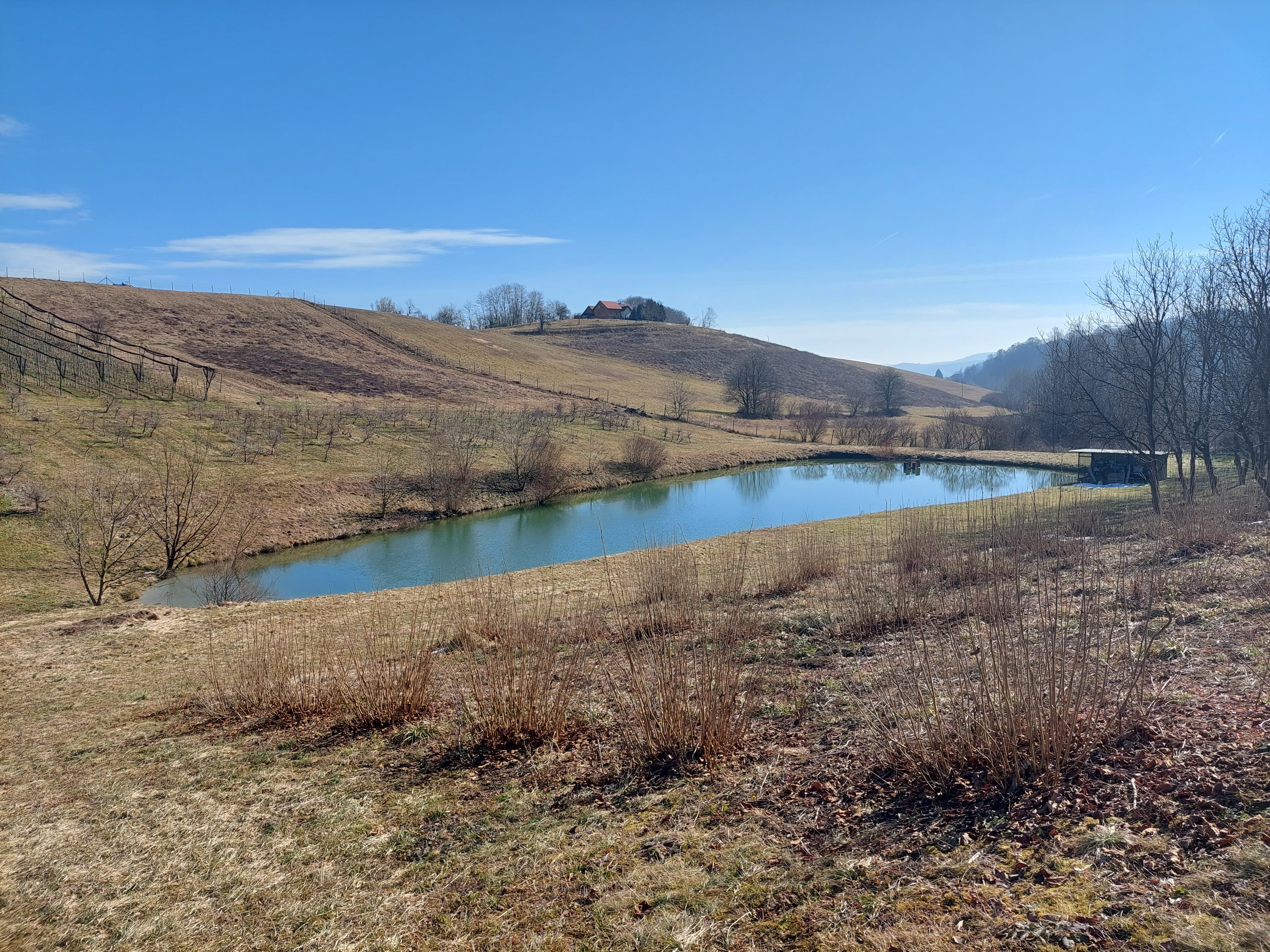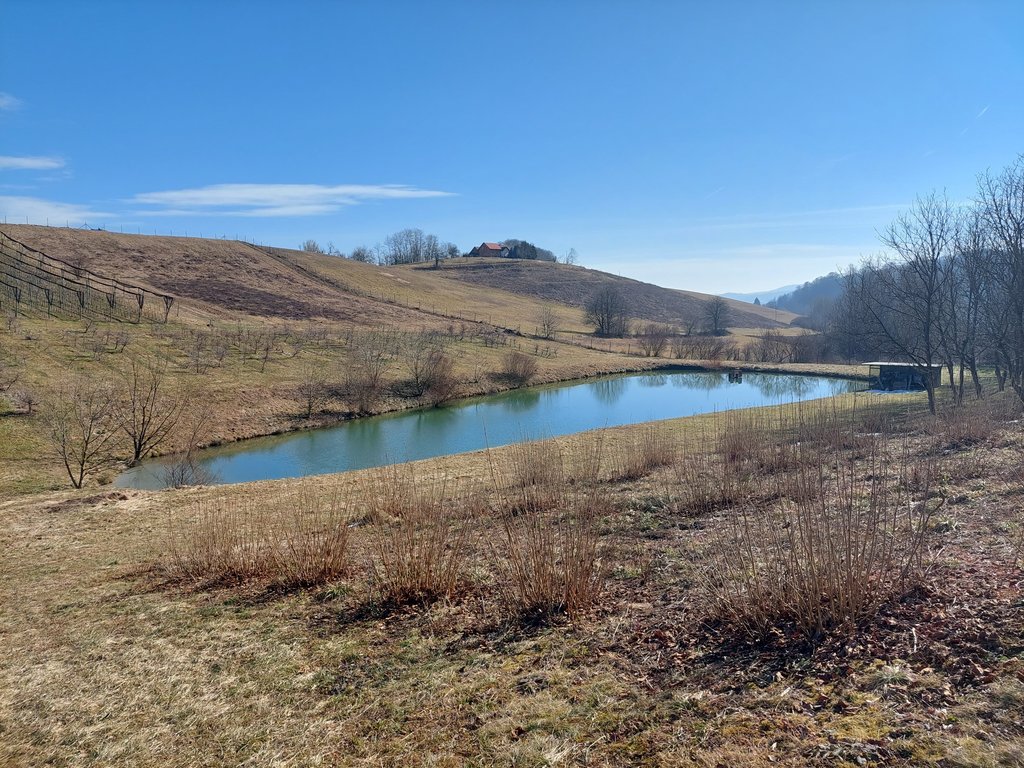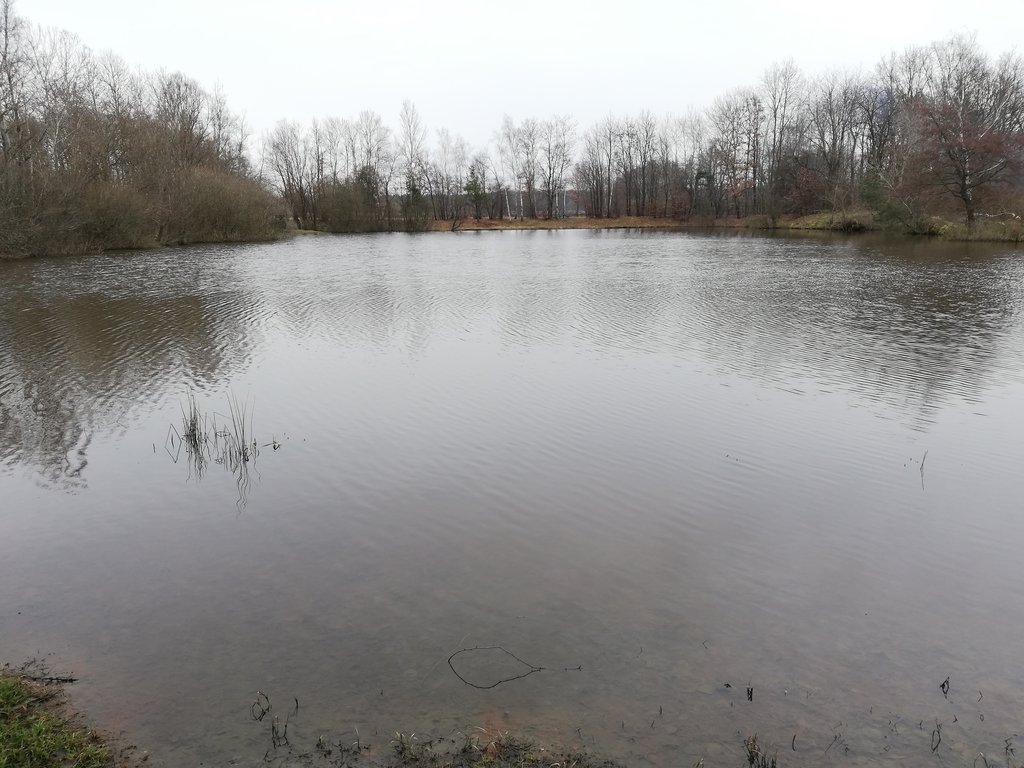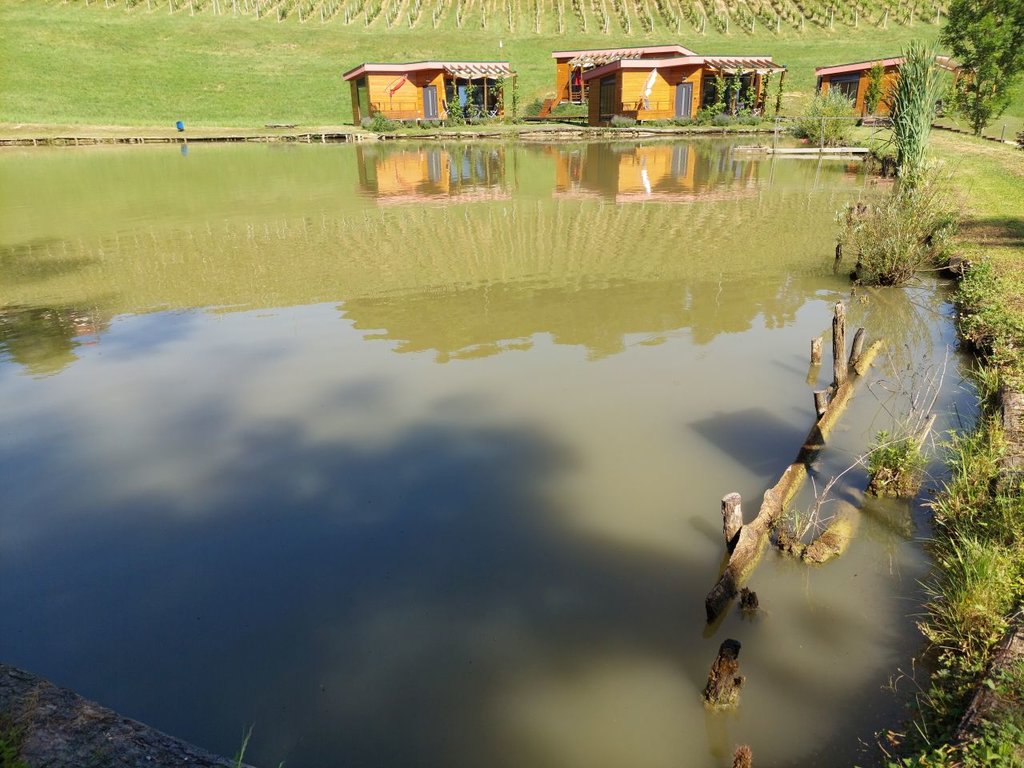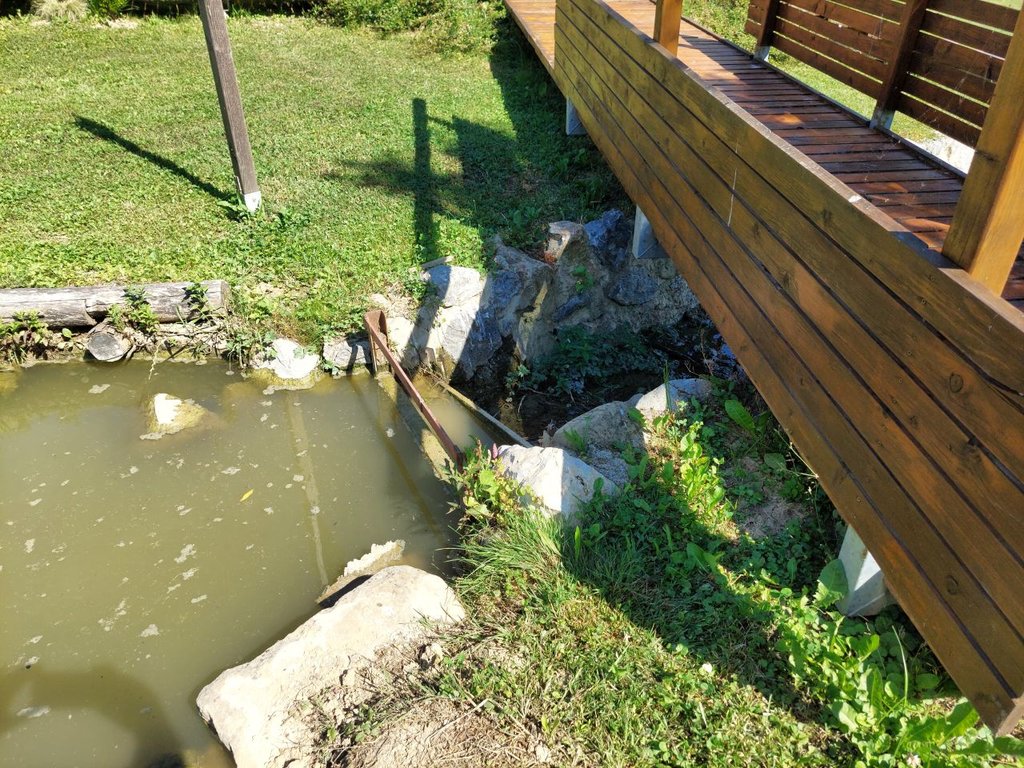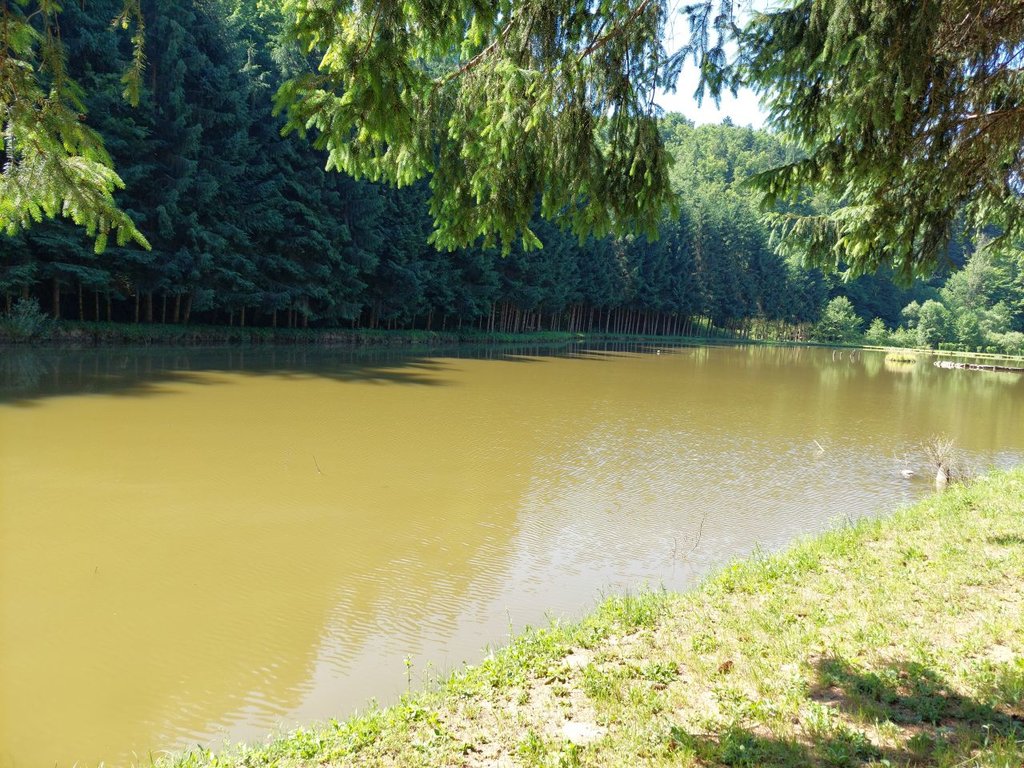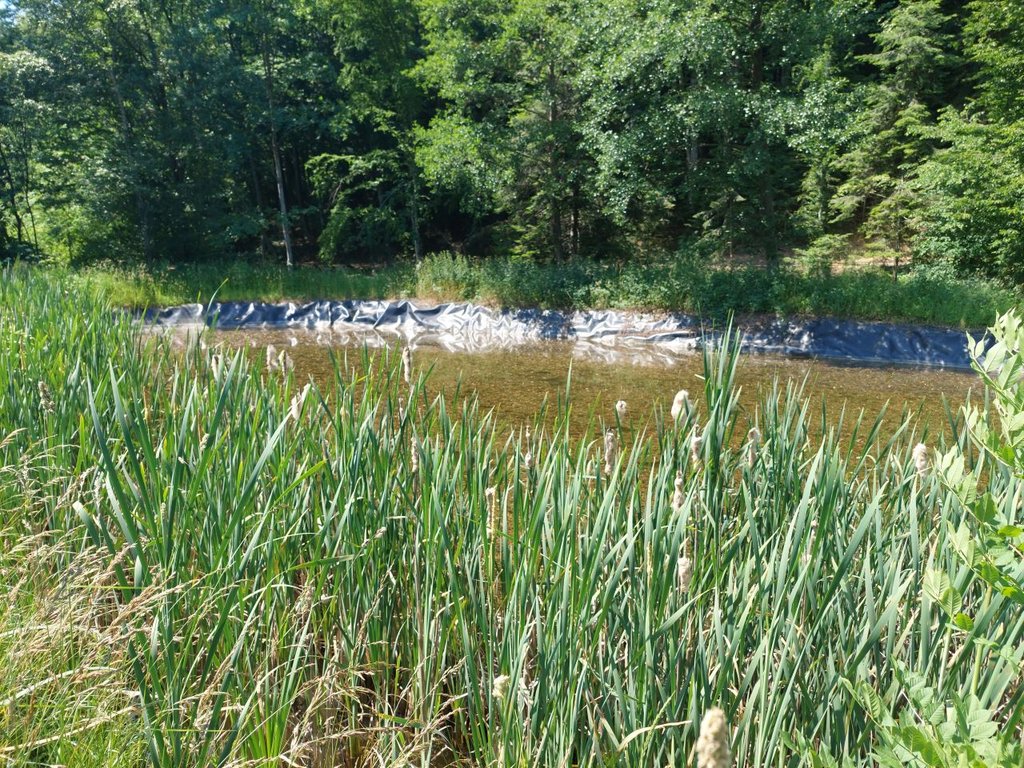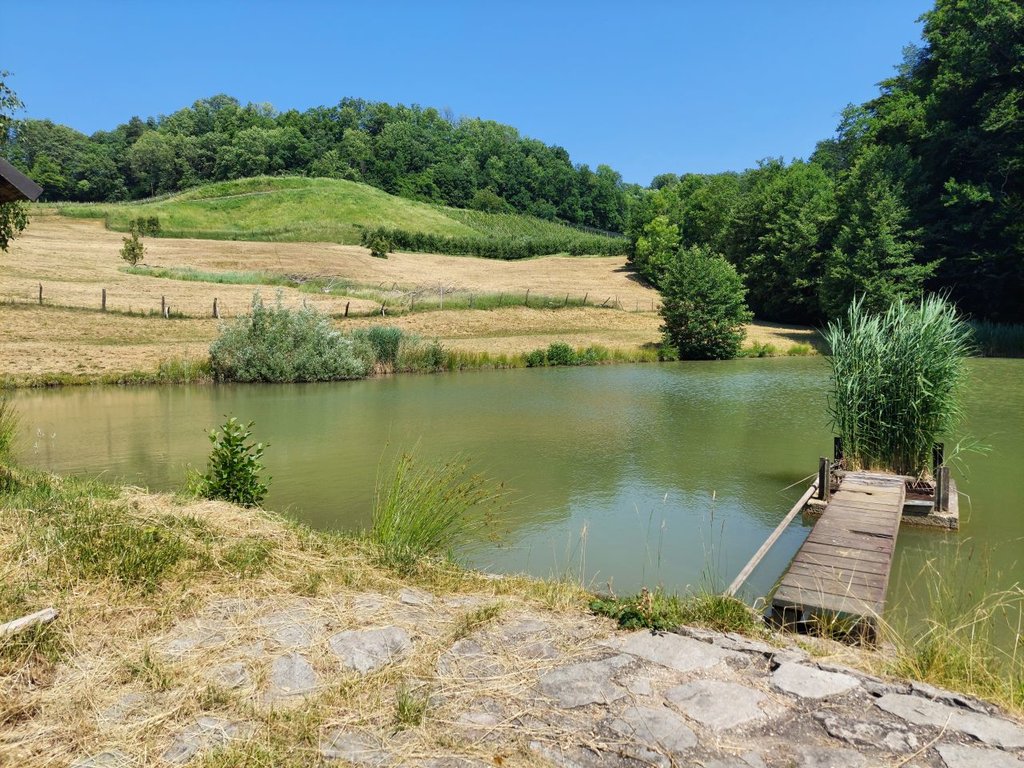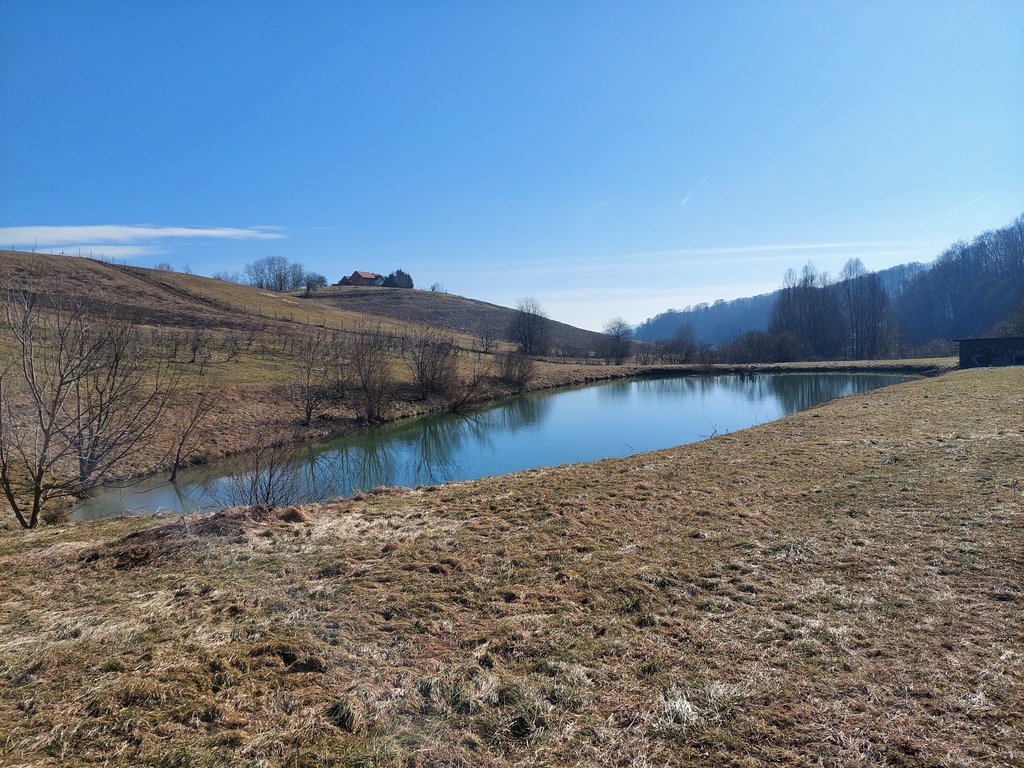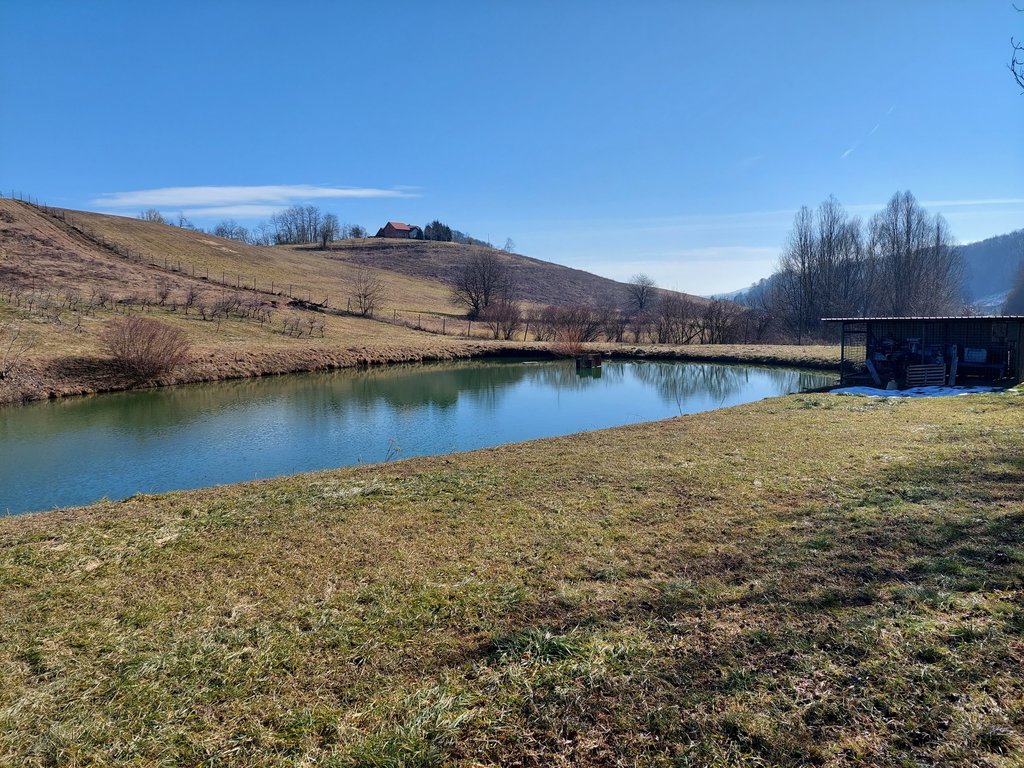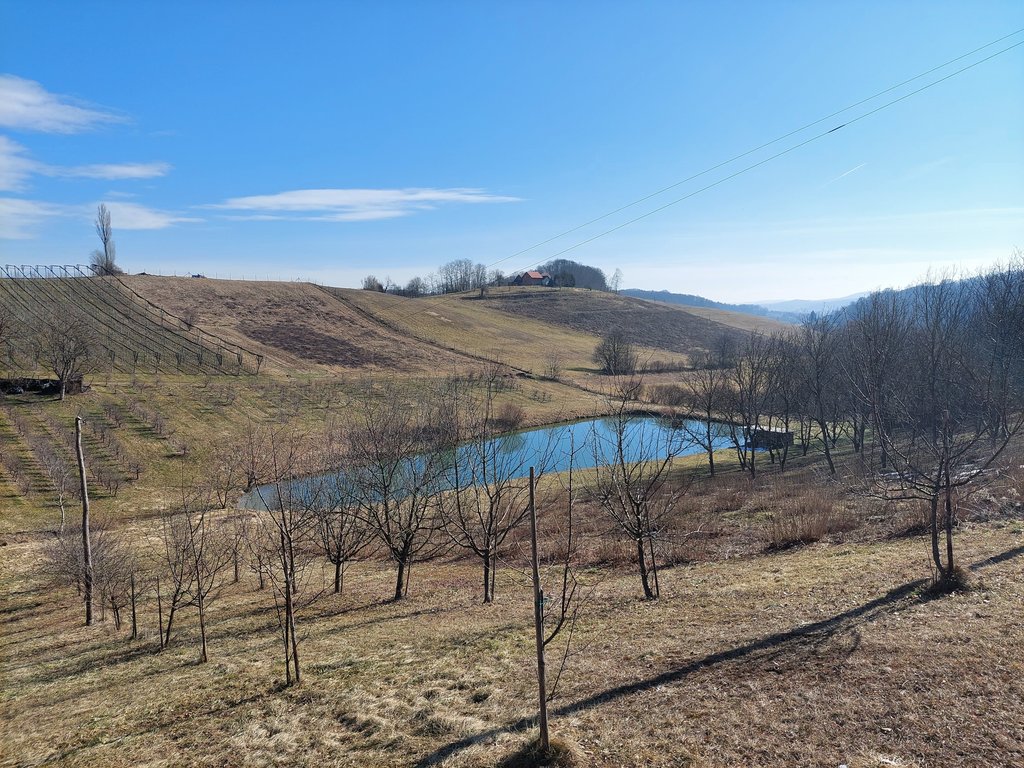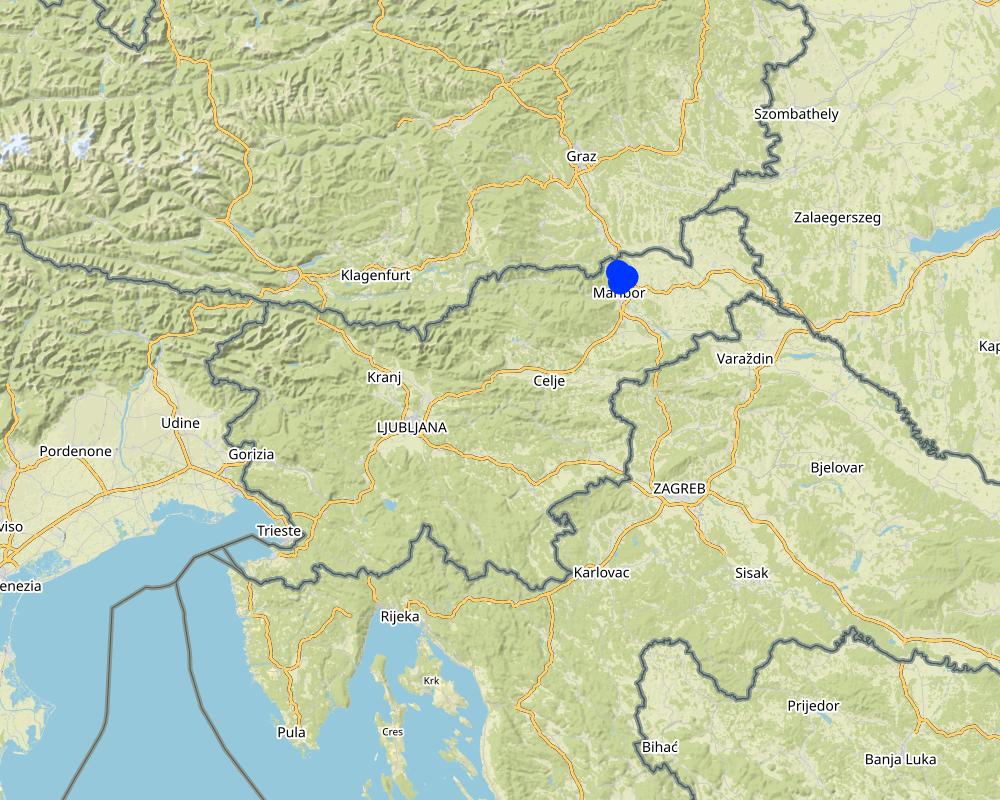Retention ponds [Slovénie]
- Création :
- Mise à jour :
- Compilateur : Gregor Kramberger
- Rédacteur : –
- Examinateurs : William Critchley, Rima Mekdaschi Studer
Mokri zadrževalniki vode
technologies_5933 - Slovénie
Voir les sections
Développer tout Réduire tout1. Informations générales
1.2 Coordonnées des personnes-ressources et des institutions impliquées dans l'évaluation et la documentation de la Technologie
Spécialiste GDT:
Spécialiste GDT:
Istenič Darja
Faculty of Civil and Geodetic Engineering, University of Ljubljana
Slovénie
Spécialiste GDT:
Škerjanec Mateja
Faculty of Civil and Geodetic Engineering, University of Ljubljana
Slovénie
Spécialiste GDT:
Banovec Primož
Faculty of Civil and Geodetic Engineering, University of Ljubljana
Slovénie
Spécialiste GDT:
Curk Miha
Biotechnical Faculty, University of Ljubljana
Slovénie
Spécialiste GDT:
Cvejić Rozalija
Biotechnical Faculty, University of Ljubljana
Slovénie
exploitant des terres:
Purgaj Donik Biserka
Fruit center Maribor (demonstrartion plantation centre), Institute of Agriculture and Forestry Maribor
Slovénie
Nom du projet qui a facilité la documentation/ l'évaluation de la Technologie (si pertinent)
OPtimal strategies to retAIN and re-use water and nutrients in small agricultural catchments across different soil-climatic regions in Europe (OPTAIN)Nom du ou des institutions qui ont facilité la documentation/ l'évaluation de la Technologie (si pertinent)
Chamber of Agriculture and Forestry of Slovenia – Institute of Agriculture and Forestry Maribor (KGZS) - SlovénieNom du ou des institutions qui ont facilité la documentation/ l'évaluation de la Technologie (si pertinent)
University of Ljubljana (UL) - Slovénie1.3 Conditions relatives à l'utilisation par WOCAT des données documentées
Le compilateur et la(les) personne(s) ressource(s) acceptent les conditions relatives à l'utilisation par WOCAT des données documentées:
Oui
1.4 Déclaration sur la durabilité de la Technologie décrite
Est-ce que la Technologie décrite ici pose problème par rapport à la dégradation des terres, de telle sorte qu'elle ne peut pas être déclarée comme étant une technologie de gestion durable des terres?
Non
Commentaires:
With improper implementation and intended use, it can have a negative effect on sustainability in the environment. It can be sustainable if properly anticipated/planned. The construction of the pond is usually subject to an environmental impact assessment where these matters are resolved as to whether it is sustainable or not.
2. Description de la Technologie de GDT
2.1 Courte description de la Technologie
Définition de la Technologie:
Retention ponds (e.g. flood storage reservoirs, shallow impoundments) are water bodies, storing water to attenuate surface runoff during rainfall events. They provide storage as well as improving water quality. Retention ponds may also be used for irrigation of farmland.
2.2 Description détaillée de la Technologie
Description:
“Retention ponds” comprise both simple, small ponds (up to 2000 m3, up to 4 m deep) and larger, more complex reservoirs (greater than 2000 m3). Retention ponds are designed to provide storage capacity to attenuate surface runoff during rainfall events. Each consists of a permanent ponded area with landscaped banks. Retention ponds achieve both storm water attenuation and water quality treatment through supplementary storage capacity of runoff. Water is then released at a controlled rate once the risk of flooding has passed. The technology can be applied in a natural or human environment. Before construction of a pond it is essential to follow legislation, which covers conditions and restrictions for the given location. Once a site is selected, technical documentation is prepared: first the conceptual design, then documentation for obtaining opinion, consent and a building permit. Later there is also project documentation for implementation. If the water is to be used for other purposes as well (e.g. for irrigation), it is necessary to plan for usage and environmental impact. Retention and still water promotes pollutant removal through sedimentation, while aquatic vegetation and biological uptake mechanisms offer additional treatment. Retention ponds are effective in removing urban pollutants and improving water quality.
They are created either by using an existing natural depression, or by excavating a new depression, or by constructing embankments. Existing natural water bodies should not be used however, due to the risk that pollution events and poorer water quality might disturb/damage the natural ecology of the system. A great benefit of retention ponds is that they hold water when there is an excess of it, which can be used later when water is not available (e.g. for irrigation). Irrigation users are farmers, so they see the advantage of using a retention system. In addition to irrigation, water has also been needed in recent years for anti-frost systems (sprinkling a consistent layer of water on the crop during an entire frost event until temperatures are back to safe levels). Disadvantages are mainly restrictions in some areas (e.g. protected areas), preparation of demanding documentation and bureaucracy, and lengthy procedures for obtaining permits.
2.3 Photos de la Technologie
2.5 Pays/ région/ lieux où la Technologie a été appliquée et qui sont couverts par cette évaluation
Pays:
Slovénie
Région/ Etat/ Province:
Podravska region, Slovenia
Autres spécifications du lieu:
Pesnica
Spécifiez la diffusion de la Technologie:
- appliquée en des points spécifiques ou concentrée sur une petite surface
Est-ce que les sites dans lesquels la Technologie est appliquée sont situés dans des zones protégées en permanence?
Non
Commentaires:
Setting up a measure in a protected area is limited and very difficult due to construction restrictions in such an environment.
Map
×2.6 Date de mise en œuvre de la Technologie
Si l'année précise est inconnue, indiquez la date approximative: :
- il y a entre 10-50 ans
2.7 Introduction de la Technologie
Spécifiez comment la Technologie a été introduite: :
- dans le cadre d'un système traditionnel (> 50 ans)
- par le biais de projets/ d'interventions extérieures
Commentaires (type de projet, etc.) :
In the 1990s, the state financed the construction of several water reservoirs in the area.
3. Classification de la Technologie de GDT
3.1 Principal(aux) objectif(s) de la Technologie
- améliorer la production
- protéger un bassin versant/ des zones situées en aval - en combinaison avec d'autres technologies
- réduire les risques de catastrophes
- s'adapter au changement et aux extrêmes climatiques et à leurs impacts
- créer un impact économique positif
3.2 Type(s) actuel(s) d'utilisation des terres, là où la Technologie est appliquée
Les divers types d'utilisation des terres au sein du même unité de terrain: :
Non

Voies d'eau, plans d'eau, zones humides
- Etangs, barrages, retenues d'eau
Principaux produits/ services:
Retention of water, collection of water. Retention ponds are ponds or basins designed with additional storage capacity to attenuate surface runoff during rainfall events. In dry years, the water can be used for agriculture, e.g. for irrigation.
3.3 Est-ce que l’utilisation des terres a changé en raison de la mise en œuvre de la Technologie ?
Est-ce que l’utilisation des terres a changé en raison de la mise en œuvre de la Technologie ?
- Oui (Veuillez remplir les questions ci-après au regard de l’utilisation des terres avant la mise en œuvre de la Technologie)
Les divers types d'utilisation des terres au sein du même unité de terrain: :
Non

Voies d'eau, plans d'eau, zones humides
- Voies de drainage, voies d'eau
- Marécages, zones humides
3.4 Approvisionnement en eau
Approvisionnement en eau des terres sur lesquelles est appliquée la Technologie:
- pluvial
3.5 Groupe de GDT auquel appartient la Technologie
- récupération/ collecte de l'eau
- gestion de l'irrigation (incl. l'approvisionnement en eau, le drainage)
- gestion des eaux de surface (sources, rivières, lacs, mers)
3.6 Mesures de GDT constituant la Technologie

structures physiques
- S5: Barrages/retenues, micro-bassins, étangs
3.7 Principaux types de dégradation des terres traités par la Technologie

érosion hydrique des sols
- Wt: perte de la couche superficielle des sols (couche arable)/ érosion de surface
- Wg: ravinement/ érosion en ravines
- Wo: effets hors-site de la dégradation

dégradation biologique
- Bc: réduction de la couverture végétale
- Bh: perte d’habitats
- Bq: baisse de la quantité/ biomasse
- Bs: baisse de la qualité et de la composition/ diversité des espèces
- Bp: augmentation des insectes nuisibles (ravageurs)/ maladies, baisse des prédateurs

dégradation hydrique
- Ha: aridification
- Hs: changement de la quantité d’eau de surface
- Hg: changement du niveau des nappes phréatiques (eaux souterraines) et des aquifères
- Hp: baisse de la qualité des eaux de surface
- Hq: baisse de la qualité des eaux souterraines
3.8 Prévention, réduction de la dégradation ou réhabilitation des terres dégradées
Spécifiez l'objectif de la Technologie au regard de la dégradation des terres:
- prévenir la dégradation des terres
Commentaires:
To prevent erosion.
4. Spécifications techniques, activités, intrants et coûts de mise en œuvre
4.1 Dessin technique de la Technologie
Spécifications techniques (associées au dessin technique):
Water retention pond – excavation scheme. R is the top radius of pond, while r is the base radius; h is the height and a refers to the bank slope. Storage volume is estimated by radius r and height h (Figure). We consider potential storage volumes of 5,000 m3 to 10,000 m3.
Prior to start of construction, detention/retention ponds should be designed by a registered design professional. Plans and specifications should be referred to by field personnel throughout the construction process. When placing a detention/retention pond in a space in the first phase it is necessary to produce a conceptual design of the intended construction of a pond, which must show the purpose and goals of the retaining wall, the size of the pond, the location, a list of plots that are encroached upon, distances from neighboring land and neighboring buildings, anticipated activities in the impoundment area, impoundment volume, barrier size data, including stability assessment, and geotechnical data (Hočuršćak 2017). When planning construction of the pond, attention should be paid primarily to the impact on the actual use of space from the point of view of water management regulations, which defines the area of use and activity restrictions, due to the possible negative impact on water and coastal lands, aquatic habitats and the ecosystem created by the construction of the reservoir. After talking with the designer, in order to obtain a water permit and consent from the authorities, it is necessary to prepare technical documentation for the installation and construction, which must also include the basis for monitoring operation and maintenance (Hočuršćak 2017). The technical documentation (dimensioning of the reservoir) may differ from the microlocation and purpose or use of the measure, e.g. if pool is intended only to contain high water, sediment or debris laoding, will it be inhabited by aquatic animals, will water be used for irrigation, drinking, etc. We also consider the shape and size of the area to identify those better suited for allocating ponds also in terms of space availability. For example, it is necessary to exclude locations with a greater slope and distance from the river considering higher slope and distance is more difficult and costly to construct. We also exclude locations where the construction of a pond is not possible because they are too narrow or too small. We should consider water retention ponds as elements of a green infrastructure network together with other natural elements (e.g. vegetated riparian zones) and protected areas (e.g. Natura, 2000 sites) with a pond design that embeds features that enhance their ecological functionality. These include mild-sloped sides with vegetated buffers along the shorelines and vegetated floating islands that facilitate the nesting of birds. We refer to excavated ponds, with no weirs or dams, since inline ponds are more costly and may have negative ecological impacts (A. Staccione et al. 2021).
Presentation of the water reservoir at the Sadjarski Center Maribor (translated: Fruit Growing Center Maribor):
The Sadjarski Center Maribor is located on a sloping terrain, which is pedologically and configuratively quite diverse, with slopes ranging from 5-15%. The soil structure is clayey loam with a basaltic substrate. In the lower, flatter part, the soil was waterlogged, which was resolved through drainage systems. These drains are directed towards a drainage ditch, which serves as the foundation for the pond and is fed by two smaller springs. The intake point is located at the lowest point and at the southernmost part of the complex. It covers an area of 3000 m2 and has a depth of up to 3.8 m. Its capacity is 5500 m3 of water when fully filled. At its southern part, there is a concrete overflow structure (spillway) with a height of 3.8 m, which is used to drain excess water and regulate the water level. A concrete pipe, 20 m in length and 80 cm in diameter, is connected to it for the discharge of excess water. On the western side, a concrete pumping platform with a canopy and an oil trap has been constructed. It houses a 185 kW (252 HP) DAF diesel generator and a Capprari flow pump with a capacity of 300 l/min (18.0 m3/h). The pumping unit is used for filling the reservoir of the irrigation fertigation system.
Auteur:
A. Staccione et al.
Date:
2021
Spécifications techniques (associées au dessin technique):
Ponds should contain the following zones (NWRM.eu, retention ponds):
- a sediment forebay or other form of upstream pre-treatment system (i.e. as part of an upstream management train of sustainable drainage components),
- a permanent pool which will remain wet throughout the year and is the main treatment zone,
- a temporary storage volume for flood attenuation, created through landscaped banks to the permanent pool,
- a shallow zone or aquatic bench which is a shallow area along the edge of the permanent pool to support wetland planting, providing ecology, amenity and safety benefits.
Additional pond design features should include an emergency spillway for safe overflow when storage capacity is exceeded, maintenance access, a safety bench, and appropriate landscaping (NWRM.eu, retention ponds).
NWRM.eu, retention ponds suggest;
- The ratio of flow path length to width in the pond should be between 3:1 and 5:1. Inlets and outlets should be placed to maximise the flow path length through the pond.
- Ponds should be wedge-shaped in plan so flow enters the pond and gradually spreads out, improving the sedimentation process and potential improvement in water quality.
- The depth of the permanent pool should be between 1.2 m and 2.0 m. Deeper pools may be subject to stratification and anoxic conditions. Shallower pools may be prone to algal blooms and high biological activity during summer months.
- Side slopes should not be steeper than 1:3 to ensure public safety and maintenance access.
- Residence time of permanent pond should be at least 20 days to allow for biological treatment of dissolved pollutants where this is required.
- Additional storage volume drained in 24-72 hours after the rainfall event depending on the intensity and duration of the storm and the design specifications of the pond
- Outfall design should be such that at least 50% of the maximum storage volume is discharged within 24 hours to allow for multiple events
- Retention ponds should ideally be combined with upstream sustainable drainage components, such as smaller detention basins and swales, which offer primary treatment and sediment management.
- Regular inspection and maintenance is important for the effective operation of ponds as designed.
Regular maintenance activities include litter and debris removal; vegetation maintenance (including cutting of bank and aquatic vegetation and removal of nuisance plants); inlet/outlet inspection and maintenance; and sediment removal from forebay (where applicable). Less frequent maintenance may include sediment removal from permanent pond; repairs; ongoing inspections and monitoring.
Appropriate signage to warn of water depth must be included for public safety.
4.2 Informations générales sur le calcul des intrants et des coûts
Spécifiez la manière dont les coûts et les intrants ont été calculés:
- par entité de la Technologie
Précisez l'unité:
pond
Précisez les dimensions de l'unité de terrain (le cas échéant):
5500
autre/ monnaie nationale (précisez):
EUR
Indiquez le taux de change des USD en devise locale, le cas échéant (p.ex. 1 USD = 79.9 réal brésilien): 1 USD = :
0,97
Indiquez le coût salarial moyen de la main d'œuvre par jour:
90.90
4.3 Activités de mise en place/ d'établissement
| Activité | Calendrier des activités (saisonnier) | |
|---|---|---|
| 1. | Costs of obtaining construction, technical and project documentation | 1-2 years before before starting construction |
| 2. | Construction of a pond | 1st year |
| 3. | Costs of supervision of construction and craftsmanship | 1st year |
4.4 Coûts et intrants nécessaires à la mise en place
Si vous n'êtes pas en mesure de décomposer les coûts dans le tableau précédent, donnez une estimation du coût total de la mise en place de la Technologie:
73600,0
Si le coût n'est pas pris en charge à 100% par l'exploitant des terres, indiquez qui a financé le coût restant:
The construction of a water reservoir can be subsidized from various sources (EU, state, municipalities, etc.). The largest share of support can be obtained through the Rural Development Program, where an investment can receive support ranging from 30% to 50% of eligible project cost (establishment cost).
Commentaires:
The costs include excavation costs and bottom waterproofing costs. Determining the exact establishment costs for the entire project was challenging due to variations in location, topography, size, shape, dimensions, materials, soil permeability, and other factors. The specific establishment cost for the retention pond at the case study location is not available or relevant, as it would be significantly lower than the cost of constructing such a pond today (due to inflation). Therefore, we decided to use projected values based on the maximum eligible costs set by the Ministry of Agriculture for grant applications, which amount to 13.38 €/m3 (2016). This value represents the justified project cost for constructing the retention pond. In this scenario, the estimated establishment cost for a typical 5000 m3 pond would be 66,900.00 €.
4.5 Activités d'entretien/ récurrentes
| Activité | Calendrier/ fréquence | |
|---|---|---|
| 1. | Energy for pumping | annually |
| 2. | water fee | annually |
| 3. | Maintenance costs (vegetation management, inspections, infrastructure maintenance, mulching, invasive species removal, pumping the entire pond for cleaning and sediment removal, sludge cleaning, monitoring, bank stabilization, replacement of damaged parts, and sealing, etc.) | annually |
4.6 Coûts et intrants nécessaires aux activités d'entretien/ récurrentes (par an)
Si vous n'êtes pas en mesure de décomposer les coûts dans le tableau précédent, donnez une estimation du coût total de l'entretien de la Technologie:
3000,0
Commentaires:
Obtaining precise costs for maintaining the pond and its surroundings is challenging, as it involves various factors. The costs can include anything from labor hours and manual mowing around the pond to considering professionals for inspections, infrastructure maintenance, mulching, invasive species removal, pumping the entire reservoir for cleaning and sediment removal, sludge cleaning, monitoring, bank stabilization, replacement of damaged parts, sealing, and more. The exact costs are difficult to determine due to the highly diverse infrastructure present in different locations. We have estimated the costs per square meter of the area under maintenance, which includes both the surrounding land and the water surface. If it's only about cleaning the surroundings of the reservoir, we consider only the land area. However, if it involves cleaning within the reservoir, we also take into account the water surface area. The best rough estimates we have range from 1 to 5 € per square meter.
4.7 Facteurs les plus importants affectant les coûts
Décrivez les facteurs les plus importants affectant les coûts :
Construction costs are affected by the shape, size, depth and microlocation of the pond layout. In addition, the cost is also influenced by the purpose of use (e.g. if pool is intended only to contain high water, sediment or debris laoding, will it be inhabited by aquatic animals, will water be used for irrigation, drinking, etc.). Geomechanically conditions are also important, because ponds and reservoirs can affect slope stability and induce landslides. The value of the investment can vary greatly depending on the design of the pond, location, water content of the area, soil structure, climate conditions,... so it is impossible to determine the exact values for pond construction, but we can only give an estimation.
5. Environnement naturel et humain
5.1 Climat
Précipitations annuelles
- < 250 mm
- 251-500 mm
- 501-750 mm
- 751-1000 mm
- 1001-1500 mm
- 1501-2000 mm
- 2001-3000 mm
- 3001-4000 mm
- > 4000 mm
Spécifiez la pluviométrie moyenne annuelle (si connue), en mm:
1080,00
Spécifications/ commentaires sur les précipitations:
The most precipitation falls in summer, the months with the highest average precipitation are June and August, the least precipitation falls in winter, in January and February at least, and in principle more precipitation falls in autumn than in spring.
Indiquez le nom de la station météorologique de référence considérée:
Jareninski vrh (1981 – 2010)
Zone agro-climatique
- subhumide
Mean annual temperature in year 2014 Jareninski vrh is 11,9°C.
5.2 Topographie
Pentes moyennes:
- plat (0-2 %)
- faible (3-5%)
- modéré (6-10%)
- onduleux (11-15%)
- vallonné (16-30%)
- raide (31-60%)
- très raide (>60%)
Reliefs:
- plateaux/ plaines
- crêtes
- flancs/ pentes de montagne
- flancs/ pentes de colline
- piémonts/ glacis (bas de pente)
- fonds de vallée/bas-fonds
Zones altitudinales:
- 0-100 m
- 101-500 m
- 501-1000 m
- 1001-1500 m
- 1501-2000 m
- 2001-2500 m
- 2501-3000 m
- 3001-4000 m
- > 4000 m
Indiquez si la Technologie est spécifiquement appliquée dans des:
- situations concaves
Commentaires et précisions supplémentaires sur la topographie:
There are depressions, settlements are in the valley, concave type.
5.3 Sols
Profondeur moyenne du sol:
- très superficiel (0-20 cm)
- superficiel (21-50 cm)
- modérément profond (51-80 cm)
- profond (81-120 cm)
- très profond (>120 cm)
Texture du sol (de la couche arable):
- moyen (limoneux)
- fin/ lourd (argile)
Texture du sol (> 20 cm sous la surface):
- moyen (limoneux)
- fin/ lourd (argile)
Matière organique de la couche arable:
- moyen (1-3%)
5.4 Disponibilité et qualité de l'eau
Profondeur estimée de l’eau dans le sol:
5-50 m
Disponibilité de l’eau de surface:
bonne
Qualité de l’eau (non traitée):
uniquement pour usage agricole (irrigation)
La qualité de l'eau fait référence à:
eaux de surface
La salinité de l'eau est-elle un problème? :
Non
La zone est-elle inondée?
Oui
Régularité:
épisodiquement
Commentaires et précisions supplémentaires sur la qualité et la quantité d'eau:
Hydro melioration was carried out in the area, a drainage system and water retention systems (e.g. ponds and basins) were arranged.
5.5 Biodiversité
Diversité des espèces:
- moyenne
Diversité des habitats:
- moyenne
5.6 Caractéristiques des exploitants des terres appliquant la Technologie
Sédentaire ou nomade:
- Sédentaire
Orientation du système de production:
- commercial/ de marché
Revenus hors exploitation:
- 10-50% de tous les revenus
Niveau relatif de richesse:
- moyen
Individus ou groupes:
- individu/ ménage
- employé (entreprise, gouvernement)
Niveau de mécanisation:
- mécanisé/ motorisé
Genre:
- femmes
- hommes
Age des exploitants des terres:
- personnes d'âge moyen
Indiquez toute autre caractéristique pertinente des exploitants des terres:
Manager of an agricultural company - fruit center - poblic demonstration plantation.
5.7 Superficie moyenne des terres utilisées par les exploitants des terres appliquant la Technologie
- < 0,5 ha
- 0,5-1 ha
- 1-2 ha
- 2-5 ha
- 5-15 ha
- 15-50 ha
- 50-100 ha
- 100-500 ha
- 500-1 000 ha
- 1 000-10 000 ha
- > 10 000 ha
Cette superficie est-elle considérée comme de petite, moyenne ou grande dimension (en se référant au contexte local)?
- moyenne dimension
5.8 Propriété foncière, droits d’utilisation des terres et de l'eau
Propriété foncière:
- entreprise
Droits d’utilisation des terres:
- individuel
Droits d’utilisation de l’eau:
- communautaire (organisé)
Est-ce que les droits d'utilisation des terres sont fondés sur un système juridique traditionnel?
Non
Précisez:
They are based on national legal system
5.9 Accès aux services et aux infrastructures
santé:
- pauvre
- modéré
- bonne
éducation:
- pauvre
- modéré
- bonne
assistance technique:
- pauvre
- modéré
- bonne
emploi (par ex. hors exploitation):
- pauvre
- modéré
- bonne
marchés:
- pauvre
- modéré
- bonne
énergie:
- pauvre
- modéré
- bonne
routes et transports:
- pauvre
- modéré
- bonne
eau potable et assainissement:
- pauvre
- modéré
- bonne
services financiers:
- pauvre
- modéré
- bonne
6. Impacts et conclusions
6.1 Impacts sur site que la Technologie a montrés
Impacts socio-économiques
Production
production agricole
Commentaires/ spécifiez:
Irrigation has avoided reduction in production due to drought and frost
qualité des cultures
Commentaires/ spécifiez:
Improved fruit health (protection against drought and frost)
risque d'échec de la production
Commentaires/ spécifiez:
Protection against drought and frost
surface de production
Commentaires/ spécifiez:
Change of land use (from agricultural land to water body).
gestion des terres
Commentaires/ spécifiez:
Increased the complexity of management.
Disponibilité et qualité de l'eau
qualité de l'eau d'irrigation
demande pour l'eau d'irrigation
Revenus et coûts
revenus agricoles
Commentaires/ spécifiez:
Production and income stability.
diversité des sources de revenus
Commentaires/ spécifiez:
Possible diversification on farm (tourism and recreation).
charge de travail
Commentaires/ spécifiez:
Demanding maintenance and increased complexity of management.
Impacts socioculturels
sécurité alimentaire/ autosuffisance
Commentaires/ spécifiez:
Lower risk of production failure, stability in business, motivation to do business in agriculture
possibilités de loisirs
Commentaires/ spécifiez:
Possible additional activities on farm.
institutions communautaires
Commentaires/ spécifiez:
An example of good practice for the community.
connaissances sur la GDT/ dégradation des terres
Commentaires/ spécifiez:
With positive effects more interest of the farmer in sustainable production.
Impacts écologiques
Cycle de l'eau/ ruissellement
quantité d'eau
Commentaires/ spécifiez:
Water available in dry months.
récolte/ collecte de l'eau
ruissellement de surface
drainage de l'excès d'eau
évaporation
Sols
humidité du sol
Commentaires/ spécifiez:
Increased in case of irrigation
perte en sol
cycle/ recharge des éléments nutritifs
Biodiversité: végétale, animale
Couverture végétale
diversité végétale
Commentaires/ spécifiez:
Planting species near/around the pond.
espèces étrangères envahissantes
Commentaires/ spécifiez:
Danger in case of improper maintenance.
diversité animale
Commentaires/ spécifiez:
For a green reservoir, a lot of green infrastructure is placed next to it, which serves as protection for animals and plants (beneficial).
espèces bénéfiques
diversité des habitats
Réduction des risques de catastrophe et des risques climatiques
impacts des inondations
glissements de terrains/coulées de débris
impacts de la sécheresse
risques d'incendies
Commentaires/ spécifiez:
Proximity to water.
microclimat
Commentaires/ spécifiez:
It affects the microclimate, more humidity, slower temperature fluctuations
6.2 Impacts hors site que la Technologie a montrés
disponibilité de l'eau
Commentaires/ spécifiez:
It is slightly increased as the ponds provide water during dry periods.
flux des cours d'eau fiables et stables en saison sèche
Commentaires/ spécifiez:
Improved mainly due to water retention during wet seasons for use in dry periods.
inondations en aval
Commentaires/ spécifiez:
Reduced due to the capacity of ponds to retain excess water during times when rivers may flood.
envasement en aval
Commentaires/ spécifiez:
The reservoir also enables sediment retention, preventing sediment from reaching downstream watercourses.
pollution des rivières/ nappes phréatiques
Commentaires/ spécifiez:
Many studies indicate that ponds can trap harmful substances, causing them to settle or undergo processes (acting as natural purification systems, especially when appropriate plant species are involved). This helps maintain cleaner downstream flows in terms of pollutants.
capacité tampon/de filtration
Commentaires/ spécifiez:
The pond's ability to retain pollutants also contributes to its buffering and filtering capacity.
6.3 Exposition et sensibilité de la Technologie aux changements progressifs et aux évènements extrêmes/catastrophes liés au climat (telles que perçues par les exploitants des terres)
Changements climatiques progressifs
Changements climatiques progressifs
| Saison | Augmentation ou diminution | Comment la Technologie fait-elle face à cela? | |
|---|---|---|---|
| températures saisonnières | été | augmente | bien |
| précipitations annuelles | décroît | très bien | |
| précipitations saisonnières | printemps | augmente | très bien |
Extrêmes climatiques (catastrophes)
Catastrophes météorologiques
| Comment la Technologie fait-elle face à cela? | |
|---|---|
| pluie torrentielle locale | bien |
Catastrophes climatiques
| Comment la Technologie fait-elle face à cela? | |
|---|---|
| canicule | pas bien |
| sécheresse | très bien |
Catastrophes hydrologiques
| Comment la Technologie fait-elle face à cela? | |
|---|---|
| inondation générale (rivière) | bien |
Autres conséquences liées au climat
Autres conséquences liées au climat
| Comment la Technologie fait-elle face à cela? | |
|---|---|
| prolongement de la période de croissance | bien |
6.4 Analyse coûts-bénéfices
Quels sont les bénéfices comparativement aux coûts de mise en place (du point de vue des exploitants des terres)?
Rentabilité à court terme:
neutre / équilibrée
Rentabilité à long terme:
positive
Quels sont les bénéfices comparativement aux coûts d'entretien récurrents (du point de vue des exploitants des terres)?
Rentabilité à court terme:
positive
Rentabilité à long terme:
positive
Commentaires:
The costs of establishing a retention pond are indeed very high, and it is a substantial investment. However, especially in the case of agricultural land irrigation, the benefits can be quite favorable, particularly in terms of drought protection or frost prevention. In the long run, the investment yields significant advantages, as it enables resilience to climate change. Farmers can also receive support through rural development programs, which provide 30-50% project funding. Although the maintenance costs can be considerable, they are necessary and offer substantial benefits to farmers who irrigate their crops or protect them from frost. From land users' perspective it's positive, if they have improved production results.
6.5 Adoption de la Technologie
- 1-10%
De tous ceux qui ont adopté la Technologie, combien d'entre eux l'ont fait spontanément, à savoir sans recevoir aucune incitation matérielle, ou aucune rémunération? :
- 0-10%
Commentaires:
It is worth noting that the availability and extent of government subsidies can vary depending on the location, specific program, and eligibility criteria. In this research area, the majority of projects received partial funding from the government.
6.6 Adaptation
La Technologie a-t-elle été récemment modifiée pour s'adapter à l'évolution des conditions?
Non
6.7 Points forts/ avantages/ possibilités de la Technologie
| Points forts/ avantages/ possibilités du point de vue de l'exploitant des terres |
|---|
| Retention ponds are simple if space is provided. |
| They collect water for use in drought conditions. |
| Retention ponds manage storm water quantity and quality, lessening the transfer of pollutants and chemicals into nearby water bodies. |
| Improved storm water collection and flood control. |
| Retention ponds provide habitats for animals, organisms, and insects (biodiversity). |
| Points forts/ avantages/ possibilités du point de vue du compilateur ou d'une autre personne ressource clé |
|---|
| Local farm water retention systems allow for the detainment of water captured during spring runoff as well as during precipitation events, either directly or due to transport by surface runoff. This provides water storage that can be drawn on when groundwater supplies become depleted. |
| Retention ponds are designed to hold excess storm water runoff and release it slowly to avoid flooding downstream areas. They also serve to reduce downstream peak flow and aid in retaining flood waters which reduces associated flood risks downstream. If water is released from the reservoir, they serve to replenish groundwater stores downstream. |
| Surface water retention systems have shown success in reducing nutrient and sediment loading in various locations worldwide. |
| Under drought conditions these systems enable farmers to draw water from the reservoirs to support crop irrigation. The main value of water retention ponds is related to agricultural water demand in the dry season. They are considered the only effective way to preserve agricultural productivity. The ponds can increase the monetary value of agricultural land that can cope with water needs. |
| In addition to the primary function of retaining high waters, they often also serve a multipurpose use, such as: supply of drinking water, irrigation of agricultural land, protection against erosion, aquaculture, fishing, energy source, preservation of landscape and biodiversity, tourism, recreation and others. |
| Biomass production is another benefit of multi-purpose surface water retention system – cattails bioproduction and nutrient management. |
| In the case of construction of the so-called of a "green" water reservoir, green infrastructure solutions can provide protection for various species of animals and plants, which promotes biodiversity. |
6.8 Faiblesses/ inconvénients/ risques de la Technologie et moyens de les surmonter
| Faiblesses/ inconvénients/ risques du point de vue de l’exploitant des terres | Comment peuvent-ils être surmontés? |
|---|---|
| Anaerobic conditions can occur without regular inflow. | Proper planning and dimensioning of the pond, location and water level are necessary. It is necessary to ensure adequate flow and depth of the pond. |
| May not be suitable for steep sites, due to requirement for high embankments. | The construction of the pond is planned at a suitable location. |
| Colonisation by invasive species could increase maintenance and pose a danger to cultivated areas. | Regular maintenance and cleaning of the pond bank is necessary. |
| Safety risk in case of slipping and falling into the pond. | It is necessary to fence and isolate the access to the pond. |
| Faiblesses/ inconvénients/ risques du point de vue du compilateur ou d'une autre personne ressource clé | Comment peuvent-ils être surmontés? |
|---|---|
| Large investments in the irrigation system and access to funds for irrigation infrastructure can be difficult to attain. | The size and holding capacity of retention systems also need to be considered to maximize benefits while limiting the initial costs of building a surface water retention system. |
| The construction requires a lot of technical preparation, planning, documentation and there are many bureaucratic obstacles to comply with the spatial acts of the municipality and to fulfil the requirements of the spatial planning authorities, which also includes large initial costs. | The preparation and management of the project should be entrusted to a professional service. Check the conditions ahead of time and plan strategically several years ahead. |
| While irrigation provides an economic gain during drought years, it also increases operational costs for water supplies. | Strategies need to provide drought proofing of crops as well as limiting damages caused by floods in non-drought years to reduce risk to farmers and the region. |
| Experts identified some barriers for greener pond implementation, especially related to reduced efficiency. The higher surface required can cause loss of water stored during summer from the higher rate of evaporation. Another risk is associated with vegetation close to the pond banks which can reduce impermeabilization and increase water infiltration due to root growth in the soil. | Good technical plan with solutions and compromises for best results with natural (green) benefits. Considering the benefits brought by green systems. |
| Unregulated relations between active/potential users, both in the delimitation of water rights, especially in times of water shortage, and in cases of regulating obligations for the proper operation and maintenance. | Collective investments with a good long-term plan for operation and maintenance. Organized management of users from the organization (e.g. municipality, etc.). |
7. Références et liens
7.1 Méthodes/ sources d'information
- visites de terrain, enquêtes sur le terrain
Field visit and conducted interview with the farm manager at the Fruit Growing Center Maribor. A working group was established, where we met 2 times to review and respond to the questionnaire.
- interviews/entretiens avec les exploitants des terres
Purgaj Donik Biserka is a farm manager of agriculture company "Fruit growing center Maribor" (land user).
- interviews/ entretiens avec les spécialistes/ experts de GDT
Matjaz Glavan, Istenič Darja, Škerjanec Mateja, Banovec Primož, Curk Miha and Cvejić Rozalija representatives from University of Ljubljana.
- compilation à partir de rapports et d'autres documents existants
As for the literature, we utilized the following documents:
- Vodnogospodarske podlage za nadzor obratovanja in vzdrževanja manjših zadrževalnikov (translated: Hydraulic basis for monitoring the operation and maintenance of small reservoirs). Miljenko Hočuršćak. Aktualni projekti s področja upravljanja z vodami in urejanje voda. 28. Mišičev vodarski dan 2017.
- Natural water retention ponds for water management in agriculture: A potential scenario in Northern Italy; Andrea Staccione, Davide Broccoli, Paolo Mazzoli, Stefano Bagli, Jaroslav Mysiak; Journal of Environmental Management 292 (2021) 112849.
Quand les données ont-elles été compilées (sur le terrain)?
10/02/2023
7.2 Références des publications disponibles
Titre, auteur, année, ISBN:
An economic assessment of local farm multi-purpose surface water retention systems in a Canadian Prairie setting; Pamela Berry, Fuad Yassin, Kenneth Belcher, Karl-Erich Lindenschmidt, Appl Water Sci (2017) 7:4461–4478.
Disponible à partir d'où? Coût?
Web
Titre, auteur, année, ISBN:
Natural water retention ponds for water management in agriculture: A potential scenario in Northern Italy; Andrea Staccione, Davide Broccoli, Paolo Mazzoli, Stefano Bagli, Jaroslav Mysiak; Journal of Environmental Management 292 (2021) 112849.
Disponible à partir d'où? Coût?
Web
Titre, auteur, année, ISBN:
Natural Water Retention Measures; Report: Individual NWRM - Retention ponds.
Disponible à partir d'où? Coût?
Web
Titre, auteur, année, ISBN:
Vodnogospodarske podlage za nadzor obratovanja in vzdrževanja manjših zadrževalnikov. Miljenko Hočuršćak. Aktualni projekti s področja upravljanja z vodami in urejanje voda. 28. Mišičev vodarski dan 2017.
Disponible à partir d'où? Coût?
Web
Liens et modules
Développer tout Réduire toutLiens
Aucun lien
Modules
Aucun module trouvé


